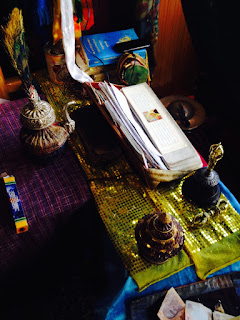My last full day in Ladakh, I decided to do some sports and visit the highest motorable pass. I booked a trip to Khardung La with a bicycle renting company. They drove me and 4 British the 40 km up to Khardung La - the height of the pass is in dispute. Indian measurement reaches 5602 m while GPS data confirms 5359 m.
The correct height does not matter when it comes to altitude sickness that can hit you here in less than 20 minutes. Signs advice tourists to cut their visit short. While the driver got our bikes from the car roof, we clicked some pictures and dressed warm for our trip downhill.
The road consisted of 15 km gravel road and 25 km asphalt. Especially, the first 7 km with the abyss right next to me I was asking myself, why I had this idea and clung to the breaks for dear life (more fearsome than the paragliding). After that the road got wider and I braver and I started to enjoy the drive downhill.
The driver always kept a bit in front or behind us in case we needed assistance. At 1 pm, we stopped for lunch at a little joint.
The view from the bike was fantastic and took your breath away.
On the road, we met a lot of oncoming traffic like jeeps, trucks and motor bikers. Most of them giving us thumps up - they probably thought we also rode the bicycle uphill. We also saw a group of donkeys making their way up and greeted the road workers with the Ladakhi "Julley" (hello).
The Leh palace sits on top of the old town, mosque and bazaar and is constructed as a multi-leveled building. I climbed up all ten levels and enjoyed a fantastic view over the valley. It was just a bit sad that all the rooms were empty and unfurnished so it was difficult to imagine how the people lived there.
Khardung La - 5602 m? 5359 m
The correct height does not matter when it comes to altitude sickness that can hit you here in less than 20 minutes. Signs advice tourists to cut their visit short. While the driver got our bikes from the car roof, we clicked some pictures and dressed warm for our trip downhill.
Don't stay too long!
No shortcut to heaven!
The road consisted of 15 km gravel road and 25 km asphalt. Especially, the first 7 km with the abyss right next to me I was asking myself, why I had this idea and clung to the breaks for dear life (more fearsome than the paragliding). After that the road got wider and I braver and I started to enjoy the drive downhill.
let's go downhill
The driver always kept a bit in front or behind us in case we needed assistance. At 1 pm, we stopped for lunch at a little joint.
lunch joint
The view from the bike was fantastic and took your breath away.
snow covered mountains in the back
On the road, we met a lot of oncoming traffic like jeeps, trucks and motor bikers. Most of them giving us thumps up - they probably thought we also rode the bicycle uphill. We also saw a group of donkeys making their way up and greeted the road workers with the Ladakhi "Julley" (hello).
After returning the bicycle, I started to explore the Leh Palace. From the old town a labyrinth of little streets, alleys and stairs led up to the former king's residence. The signs are even in German painted on the building walls.
old town
chorten in old town
The Leh palace sits on top of the old town, mosque and bazaar and is constructed as a multi-leveled building. I climbed up all ten levels and enjoyed a fantastic view over the valley. It was just a bit sad that all the rooms were empty and unfurnished so it was difficult to imagine how the people lived there.
Entrance to Leh Palace
Demons guarding the entrance
Schematics of the Leh Palace
The palace resembles the Potala in Lhasa, Tibet, and was found in the 17th century and the royal family lived there until they lost their power and were carted off to Stok.
Probable former Palace Library
View from Queen's quarters
View of the Leh Valley
On the Palace terrace
As I could not find a taxi to drive me up to the fort, I took the steep slope on foot for 15 minutes. The Tsemo Fort and Monastery were built in the 15th & 16th century and is widely seen from across Leh sitting on the top of Palace Ridge.
Tsemo Fort
On the backside, a walkway of stone and stairs leads down and back to the Changspa Road and my hotel Kang Lha Chen.
The stay in Ladakh was fantastic and I definitely want to come back - there is still open trekking and rafting in the Zanskar Valley.



















































